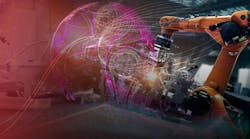At a Glance:
- Restructuring the legacy workflow allows a business to restructure its human resources in a way that is adaptable to a post-pandemic environment.
- Amongst the greatest opportunities for AI and ML is its ability to enhance operations in supply chain and logistics.
- Machines aren’t taking away humans’ jobs. Automation enables the next generation of workers to focus on learning and perfecting new approaches or techniques.
Artificial intelligence and machine learning (AI/ML) aren’t just for high-tech companies anymore. Industries like manufacturing, life sciences and retail are adopting AI/ML-based tools to help solve business challenges following the COVID-19 pandemic. Consider the chemical plant operating at reduced headcount due to social distancing or the medical manufacturer that must adapt to supply chain issues caused by an in-flux economy.
We’ve merely scratched the surface of the practical applications of these intelligent technologies in broader industries. Below are five concrete functions of AI and ML being used right now to help businesses and their employees regain momentum and stability on the other end of the crisis.
1. Reimagining Legacy Workflows
One of the most common applications of any intelligent tool is the reallocation of repetitive or mundane tasks from humans to machines. Removing predictable or tedious tasks within an existing workflow enables organizations to give employees valuable time back to focus on more complex, high-value tasks. The introduction of automated customer service representatives in retail is an example of how AI and ML are used to reimagine legacy workflows.
Traditionally, customer service representatives would be the first point of contact for consumers; however, with AI/ML-based tools, human agents are now more often the last contact point because intelligent systems can resolve the majority of inbound customer tickets on their behalf. Restructuring the legacy workflow allows a business to restructure its human resources in a way that is adaptable to a post-pandemic environment, often reassigning employees to other essential tasks and more effectively upscaling or downscaling its operations.
2. Keeping Momentum with Fewer Staff
Images of fully autonomous factory floors with robots zooming back and forth aren’t fictional anymore; this is how many manufacturing operations look today, especially for forward-thinking businesses that implemented automation ahead of the pandemic. Most factories at the moment are a combination of intelligent tools and specialized (yet sparse) human operators, who do more behind-the-scenes tasks. The industrial robot is often referred to as the “perfect pandemic worker”—one that will only continue to prove its value over time.
3. Course Correcting Supply and Logistics
Perhaps one of the greatest opportunities for AI and ML to enhance operations is in supply chain and logistics. The global supply chain is becoming more complex, coupled with an increasing demand for customized products and fiercer competition in a digital marketplace. For this reason, it’s important for companies to operate leaner while meeting the needs of their customers.
Logistics managers are incorporating AI and ML to help replenish depleted inventory by increasing speed in areas such as product development and research, as well as informing supply chain operators on contextual information that can improve inventory management and capacity planning. Furthermore, AI and ML are being used to correct transportation disruptions.
For example, a supplier sending goods from one side of the world to another can create logistics contingency plans informed by cognitive-based tools. These tools can determine if they should re-route or use alternate modes of transportation (such as by land, see or air) to reduce the impact of current logistics fluctuations.
4. Maintaining Complex Equipment
For years, AI and ML have helped industries from oil and gas to medical device manufacturing reduce asset downtime and foresee equipment failures. However, as equipment becomes more complex, AI/ML-powered systems can continue to keep pace, sometimes better than the capabilities of their human operators. To confront this, plant managers are leveraging AI/ML to proactively address maintenance issues as well as gather data from past incidents to better mitigate equipment issues.
5. Closing the Knowledge Gap
A longstanding (yet false) narrative surrounding AI and ML is that they’ll put humans out of work. Today, that presumption is being put to rest. As the U.S. struggles with labor shortages and knowledge gaps left by retiring Baby Boomers, machines are helping to close the gap. In other words, machines aren’t putting humans out of work—machines are taking jobs humans won’t. This enables younger generations to allocate existing tasks or functions to machines, so they can focus on learning and perfecting new approaches or techniques.
The COVID-19 pandemic motivated organizations to consider how intelligent tools can bring agility and precision to the operations of non-tech companies. Helping to improve factors such as speed to market, functional autonomy, supply and logistics, complex maintenance and even closing the knowledge gap, AI and ML are valuable tools that can be leveraged in a multitude of situations by a wide range of industries.
When applied in the right business context, these tools can fundamentally change the way companies discover, create, make and sell new products, which is ever-critical in times such as these.
Jordan Reynolds, is the global director of data science at Kalypso, where his team applies AI and data science-driven approaches to help manufacturers develop and realize digital transformation goals.
